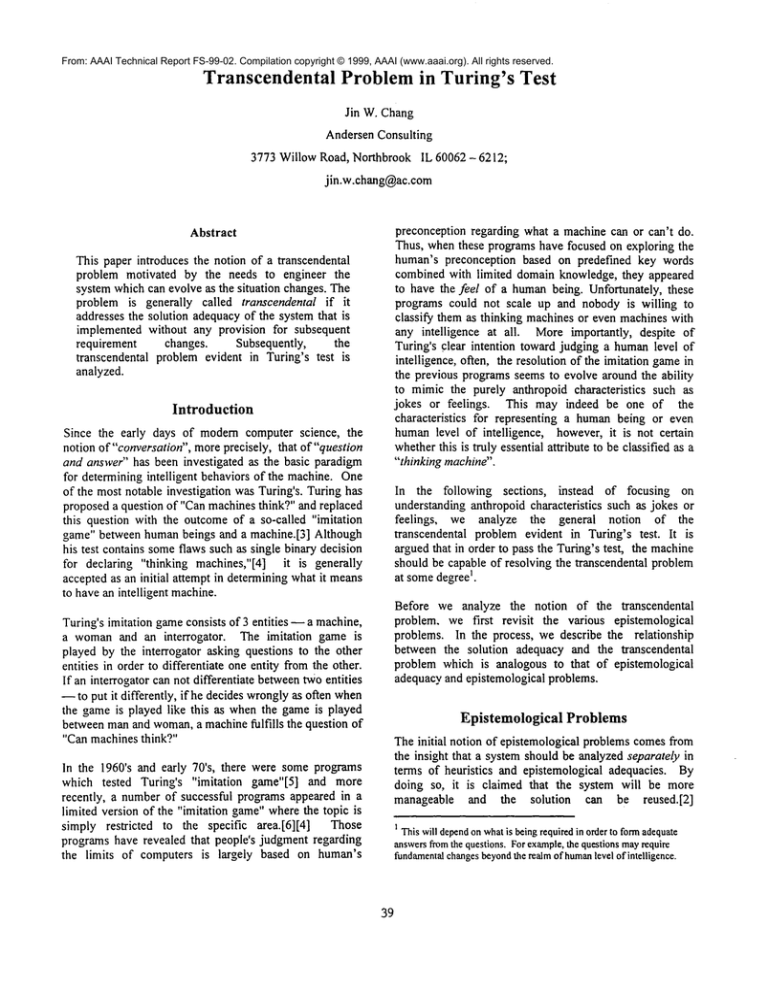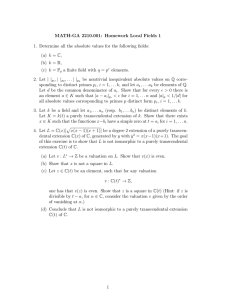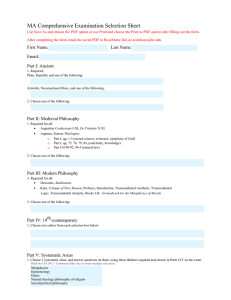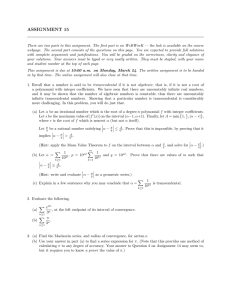
From: AAAI Technical Report FS-99-02. Compilation copyright © 1999, AAAI (www.aaai.org). All rights reserved.
Transcendental Problem in Turing’s Test
Jin W. Chang
Andersen Consulting
3773 Willow Road, Northbrook IL 60062 -6212;
jin.w.chang@ac.com
preconception regarding what a machine can or can’t do.
Thus, when these programs have focused on exploring the
human’s preconception based on predef’med key words
combined with limited domain knowledge, they appeared
to have the feel of a humanbeing. Unfortunately, these
programs could not scale up and nobody is willing to
classify them as thinking machines or even machines with
any intelligence at all. More importantly, despite of
Turing’s ¢:lear intention toward judging a humanlevel of
intelligence, otten, the resolution of the imitation gamein
the previous programsseems to evolve around the ability
to mimic the purely anthropoid characteristics such as
jokes or feelings.
This may indeed be one of the
characteristics for representing a humanbeing or even
humanlevel of intelligence, however, it is not certain
whetherthis is truly essential attribute to be classified as a
"thinking machine".
Abstract
This paper introduces the notion of a transcendental
problem motivated by the needs to engineer the
system which can evolve as the situation changes. The
problem is generally called transcendental if it
addresses the solution adequacyof the system that is
implemented without any provision for subsequent
requirement
changes.
Subsequently,
the
transcendental problem evident in Turing’s test is
analyzed.
Introduction
Since the early days of modemcomputer science, the
notion of "conversation", moreprecisely, that of "question
and answer" has been investigated as the basic paradigm
for determining intelligent behaviors of the machine. One
of the most notable investigation was Turing’s. Turing has
proposed a question of"Can machines think?" and replaced
this question with the outcome of a so-called "imitation
game" between humanbeings and a machine.[3] Although
his test contains someflaws such as single binary decision
for declaring "thinking machines,"[4] it is generally
accepted as an initial attempt in determining what it means
to have an intelligent machine.
In the following sections, instead of focusing on
understanding anthropoid characteristics such as jokes or
feelings,
we analyze the general notion of the
transcendental problem evident in Turing’s test. It is
argued that in order to pass the Turing’s test, the machine
should be capable of resolving the transcendental problem
1.
at somedegree
Before we analyze the notion of the transcendental
problem, we first revisit the various epistemological
problems. In the process, we describe the relationship
between the solution adequacy and the transcendental
problem which is analogous to that of epistemological
adequacy and epistemological problems.
Turing’s imitation gameconsists of 3 entities -- a machine,
a womanand an interrogator.
The imitation game is
played by the interrogator asking questions to the other
entities in order to differentiate one entity fromthe other.
If an interrogator can not differentiate betweentwo entities
--to put it differently, if he decides wronglyas otien when
the game is played like this as when the game is played
between manand woman,a machinefulfills the question of
"Can machines think?"
Epistemological
Problems
The initial notion of epistemological problems comes from
the insight that a system should be analyzed separately in
terms of heuristics and epistemological adequacies. By
doing so, it is claimed that the system will be more
manageable and the solution
can be reused.J2]
In the 1960’s and early 70’s, there were some programs
which tested Turing’s "imitation game"[5] and more
recently, a number of successful programs appeared in a
limited version of the "imitation game"where the topic is
simply restricted to the specific area.[6][4]
Those
programs have revealed that people’s judgment regarding
the limits of computers is largely based on human’s
I Thiswill depend
onwhatis beingrequiredin orderto formadequate
answers
fromthe questions.Forexample,
the questionsmayrequire
fundamental
changes
beyond
the realmof human
level of intelligence.
39
Consequently, a number of epistemic problems such as
frame, qualification
and ramification problems were
analyzed, and a series of formalisms were introduced to
address these problems.
Unlike the aboveepistemic problemswhich strictly address
the epistemological adequacy, the transcendental problem
arises from the lack of solution adequacy. This implies
when considering a transcendental problem, the system
should be analyzed for its entire adequacyas a packaged
"solution" which includes both epistemological and
heuristic adequacies. Unfortunately, satisfying both
adequacies does not necessarily imply the system is
solution adequate. This is because the system may be
sound in theory and implementation, but it may not be
acceptable as an adequate solution due to the lack of
required capabilities or other necessary features - for
example, the system may even solve a wrong problem.
This suggests that when implementing a complete system,
both epistemological and heuristic adequacies alone do not
determine the adequacyof a solution. Additionally, since
there are manychanges occurring throughout the lifecycle
of a system (from the initial implementation to the
deployment and overall maintenance), the solution
adequacy is very muchdependent on the current state of
the system. In other words, the system which was solution
adequate previously, maybe completely inadequate in the
future due to the requirement changes. Thus, the
transcendental
problem differs
from the other
epistemological problems in that; (1) it addresses the
overall solution adequacyof the system; (2) it is applied
throughout the evolving lifecycle of the system - i.e., the
adequacyis revalidated whenthe requirement changes.
Transcendental
Problem
One of the problems in any kind of soRware(whether it is
an A.I program or otherwise) comes from the fact that
often, it is too difficult to modify,maintainand to be scaled
up in the case of the prototype. The system may be
implementedto meet the original requirements. However,
the requirements maychange and the system may have to
be modified accordingly. Certainly, when the original
requirementis given, it can be carefully analyzed in theory
and the system may be built based on that analysis.
Furthermore, when the system is finally completed assumingit is correctly specified in theory and correctly
implemented,it has met both epistemological and heuristic
adequacies.
Now,what if the system needs to change due to changes in
previous belief or requirement? Manytimes, this causes
the existing programto becomeobsolete or quite difficult
to modify. Even when the existing program already
provides the majority of the features for the new
requirement, the changes are often non-trivial. A careful
analysis is usually needed to verify the whole newcontrol
flow and any side effects for the changes have to be
carefully analyzed. As a result, the efforts involved in
providingthe deficient features is proportionally far greater
than the original efforts and this has beenwell illustrated in
software engineering in terms of rapidly "increasing"
maintenance
costs.[ 1 ]
Whydoes this happen? This is because in reality, even a
minor heuristic or epistemological inadequacies can cause
a major solution inadequacy. Muchwork is often required
for both re-implementationand validation of the solution.
For example, consider there already exists
an
implementation of a robot whose primary task is to stack
the blocks on the table. Initially, the blocks have names
and come with the equal size. Nowthe new requirement
states that all blocks have different sizes. Furthermore,the
rule of stacking states, "The blocks can only be stacked on
the equal or larger size blocks". It will be ideal if the size
can be specified somehowin existing representation and
the rest of the procedure continues to work properly by
consulting this additional information. In other words, we
simply want to specify that the blocks can only be stacked
on the equal or larger size blocks and the rest of the
existing procedure somehowconsults the new stacking rule
and continues to work properly. Unfortunately, this is
rarely the case. The overall representation has to be
reviewed (such as block(A)) to encode the size of each
blocks such as size(block(A), small). Also, each operator
(such as stack(block(A), block(B))) has to be carefully
evaluated to ensure additional information such as ’size’ is
appropriately consulted. Furthermore, the overall control
flow has to be validated to be certain that there exist no
anomalies or dead ends introduced by this change. As a
result, the simple change in the initial requirements has
caused a major problem in modifyingthe existing solution.
In other words, the minor heuristic and epistemological
inadequacies introduced by the simple change in initial
requirements have caused a major solution inadequacy.
Even when the existing solutions were combined, the
problem of solution inadequacy maystill occur unless they
are validated as a whole. For example, again consider the
above robot and a newrequirement stating the robot needs
to sweepthe floor after it stacks the blocks. Furthermore,
assume there already exist two adequate solutions - one
stacking blocks and the other sweeping the floor.
Presumably, the existing solutions do not need to change
since they already provide adequate solutions. However,
the problemof solution inadequacy maystill occur if they
are not validated as a whole solution. For example, a
robot may simply have a limited amount of memory.
Therefore, it can not accomplishboth tasks without loosing
someessential information such as the configuration of the
4O
last stacked blocks or the current location of itself. As a
result, even if the solution adequacywas satisfied for the
previous requirements, the system may not be adequate
without a complete revalidation when new requirements
are introduced.
expressing information about what remains unchanged by
the event whichcauses situation to change(in this case it is
the "requirement change" event which causes H(S(t+k))
be inadequate), this is an epistemological problem.
Therefore, in order for E(S(t+k)) to be evaluated as
epistemologically adequate theory, it has to consider all
the changes caused by the events (i.e., requirement
changes).Subsequently,all of E(S(ti)) for i such that t i
< k, has to consider those events as well. Unforttmately,
since it is not possible to predict all the events, E(S(f))
not be equivalent with E(S(t+k)). As a result,
epistemological adequacyhas to be re-evaluated.
As is illustrated above, the problemis generally classified
as transcendental if it addresses the solution adequacyof a
system that is implemented without any provision for
subsequent requirement changes. This implies that at the
time of the initial implementation, those changes were
never anticipated by the designer. Even if those changes
were anticipated, they were never considered when the
system was initially
designed. Thus, the problem is
transcendental from the perspective of a designer and the
system whichhe built.
This implies the epistemological adequacyalone can not be
considered independently from heuristics as was argued by
Ginsberg.[7] In other words, when considering the
lifecycle of a system, the knowledgerepresentation can not
be investigated without the forethought for actual
implementation.
Whyis it important for the system to be able to easily
encounter the transcendental problem? The importance of
the transcendental problem comes from the fact that the
systems, formalisms or prototypes often appear to have
various capabilities to solve manyimportant problems, but
can not be scaled up or revised easily whenthere are small
deviations introduced to the original problem. This is
because often, they only solve the problems in either
heuristic or epistemological adequacies, and did not
consider the overall solution adequacy. To describe this
more in detail, assumethe following;
Transcendental
Problem in Turing’s
Test
In the original Turing’s test, the transcendental problem
occurs for one of the two reasons. One is that the
interrogator all the suddenretracts the previous statements
by proposing a contradictory statement. The other is due
to the lack of rigor in the initial statement. For example,
when the interrogator states, "I respect Bill and his
contribution to U.S economy", the machine may assume
the interrogator respects Bill and subsequently, whatever
positive attributes one maypossess whenone respects the
other. In the next statement, the interrogator maysimply
change his mind saying, "Based on what he has done for
evading law suits, I don’t believe I actually respect him."
When this happens, the machine has to adjust its
underlying assumptions to reflect the new statement.
Unfortunately, since the machine does not knowwhen the
interrogator will change his mind, it will be impossible to
anticipate the potential changes beforehand. This implies
the designer can not prearrange the adequate "hooks" into
the system at the time of implementation. Instead, the
designer has to ensure that the underlying schemeor the
infrastructure which implementsthe machineis adaptable.
S(t) : the state of system,S at the time oft
E(S(t)) : epistemological adequacyof S
H(S(t)) : heuristic adequacyof S
~E(S(t)) : epistemological inadequacyof S
~H(S(t)) : heuristic inadequacyof S
Given the above, assume S(t) has initially satisfied both
E(S(t)) and H(S(t)) at t. Nowat (t+l), the requirement
change for heuristics
is introduced and causes the
H(S(t+I)) to become inadequate- however, E(S(t+I))
still believed to be adequate since the change is only
limited to the heuristic adequacy. After the appropriate
modification of S at (t+2), the system again satisfies both
adequacies.
Similarly, S(t+3) -- E(S(t+3)) but --,H(S(t+3))
requirement change introduced at (t+3)
S(t+4) = E(S(t+4)) and H(S(t+4)) after the modification.
Althoughit is debatable whether a machinehas to form an
epistemological state similar to a humanbeing in order to
pass the original Turing’s test, the crux of the
transcendental problemevident in Turing’s test emphasizes
that it is not just representing this epistemological state
whichis required, but also the ability to changeits internal
state or any other characteristics whichmakeup that state 2 .
This is also apparent in the case where the initial
S(t+k) = E(S(t+k)) but ~H(S(t+k)) due to the requirement
changeintroduced at (t+k)
The question becomes howcan we ensure S(t+n) satisfies
both E(S(t+n)) and H(S(t+n)) for all of n from
regardless of requirement changes?
-" SincetheTuring’s
test is donefromthe perspective
of anexternalentity,
whether
andhowthe machine
actuallyrepresentssuchstate internallyis
notimportant
as longas it ~ exhibitnecessary
characteristics.
Since this is identical to the well knownframe problem of
41
conversation does not fully disclose the details. Fromthe
above example, the machine may immediately assume the
interrogator is talking about Bill Gates whereas it may
actually have spoken of Bill Clinton instead.
This
happened because the open, free conversation lacks the
rigor and the structures that are typically required in
traditional programminglanguages. In fact, in natural
language, it is not uncommonto find some degree of
ambiguity since the interrogator does not always specify
the detail assumptions. Instead, the interrogator relies on
the listener to makeappropriate underlying assumptions.
As the conversation progresses, it is expected that the
listener is able to adjust underlying assumptions if
necessary. This implies that each conversation session in
Turing’s test can potentially form a series of "dialogs"
which examines machine’s ability
to handle the
transcendental problem. In this regards, the Turing’s test
can also be used as a test for the transcendental problems.
However, since the original Turing’s test is open and
adopted a natural language as a conversation medium,the
notion of transcendental problem may occur at various
domains- from anthropoid characteristics such as changes
in feelings or attitudes to the explicit descriptions such as
facts or events. Althoughit maybe important to analyze a
machine which can handle the changes in the anthropoid
characteristics such as feelings or attitudes, the initial
notion of transcendental problem only focuses on the
changes in the explicit descriptions regarding the system (
i.e., analytical engine). This is because currently, the
functions which adequately capture the anthropoid
characteristics
are not well understood, and the
transcendental problem needs to address the overall
solution adequacy which embeds both epistemological and
heuristic adequacies.
Conclusion
This paper argues the transcendental problemis inherent in
the conversation associated with the Turing’s test. In
particular, the paradigmbased on Turing’s test generally
becomesa test to examine a machine’s ability to handle
transcendental problems. Furthermore, the transcendental
problemrestricts the dialog such as "question and answer"
to the domain where each response can be explicitly
understood and analyzed.
References
.
,
.
.
.
.
42
McCarthy, J. 1977. Epistemological Problems of
artificial intelligence, In Proceedings of the Fifth
International
Joint Conference on Artificial
Intelligence, pp.I038-1044.
Turing, A., 1963. Computing Machinery and
Intelligence, In Feigenbaum,E., and Feldman,J.(eds),
Computers and Thought, McGraw-Hill.
Epstein, R., 1992, The Quest for the Thinking
Computer, AI Magazine,
4.
In terms of the transcendental problem regarding the
explicit descriptions, the machine may not be equipped
with any knowledgewhen the Turing’s test first begins.
However, if the machine is capable, it will gradually
become more knowledgeable as the conversation
progresses. For example, whenthe interrogator initially
declares a number of statements, the machine needs to
accept them as an initial input. As .the. conversation
progresses, more statements will be specified and the
previous statements may be modified. Mostly, the each
conversation session declaring multiple statements
transforms to educate the machine, as well as to test the
machine’s predefined knowledge. Subsequently, the
significance of the above transcendental problems in the
Turing’s test states that the conversation mediumneeds to
be restricted to the domainwhere solution adequacycan be
satisfied by the system.
Lientz, B., and Swanson, A. 1980. Software
Maintenance
Management: A Study of the
Maintenance of Computer Application Software in
487 Data Processing Organizations, Reading, Mass.:
Addison-Wesley.
Weizenbaum, J., 1966, ELIZA- A computer program
for the study of natural language communication
between man and machine, CACM
9:36-45.
st
Weintraub, J., 1991, Whimsical Conversation, 1
Loebner Price Competition.
Ginsbe~, M. L., 1995. Epistemological and Heuristic
Adequacy Revisited. ACMComputing Surveys Vol
27. Number3:331-333.








